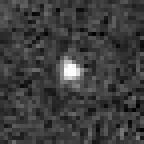10370 Hylonome facts for kids

Hubble Space Telescope image of Hylonome taken in 2009
|
|
| Discovery | |
|---|---|
| Discovered by | D. C. Jewitt J. X. Luu |
| Discovery site | Mauna Kea Obs. |
| Discovery date | 27 February 1995 |
| Designations | |
| MPC designation | (10370) Hylonome |
|
Named after
|
Ὑλονόμη Hylonomē (Greek mythology) |
| 1995 DW2 | |
| centaur · distant Neptune-crosser Uranus-grazer |
|
| Orbital characteristics | |
| Epoch 4 September 2017 (JD 2458000.5) | |
| Uncertainty parameter 3 | |
| Observation arc | 15.27 yr (5,576 days) |
| Aphelion | 31.393 AU |
| Perihelion | 18.910 AU |
| 25.152 AU | |
| Eccentricity | 0.2482 |
| 126.14 yr (46,073 days) | |
| 63.271° | |
|
Mean motion
|
0° 0m 28.08s / day |
| Inclination | 4.1443° |
| 178.08° | |
| 7.0279° | |
| Jupiter MOID | 13.4570 AU |
| TJupiter | 4.4550 |
| Physical characteristics | |
|
Mean diameter
|
70±20 km 74±16 km |
| 0.051±0.030 | |
| BR (intermed. blue-red) | |
| 8.6 · 9.08±0.04 (R) · 9.250±0.131 (R) · 9.35 · 9.51±0.08 · 9.53 | |
Imagine a small, icy world far out in our Solar System! That's 10370 Hylonome. It's a special kind of asteroid called a centaur. Centaurs are like icy wanderers that orbit between the giant planets, sometimes even crossing their paths. Hylonome was first discovered on February 27, 1995.
Scientists used the Spitzer Space Telescope to measure Hylonome. They found it's about 70 kilometers (or 43 miles) wide. That's roughly the distance from one end of a big city to the other!
What is Hylonome?
Hylonome is a minor planet, which is a small object orbiting the Sun. It's part of a group called centaurs. These centaurs are found between the orbits of Jupiter and Neptune. Hylonome's path around the Sun actually crosses the orbits of both Neptune and Uranus.
It takes Hylonome a very long time to go around the Sun. One full orbit, which is like one year for Hylonome, lasts about 126 Earth years!
How Hylonome Got Its Name
This minor planet is named after Hylonome, a female centaur from Greek mythology. In ancient Greek stories, centaurs were creatures that were half-human and half-horse.
Hylonome was known for her deep love for her husband, Cyllarus. When Cyllarus was hurt, Hylonome was so heartbroken that she chose to stay with him forever. This naming helps us connect the wonders of space with ancient tales. The official name was announced on July 26, 2000.
Related pages

